On land, in the air and at sea
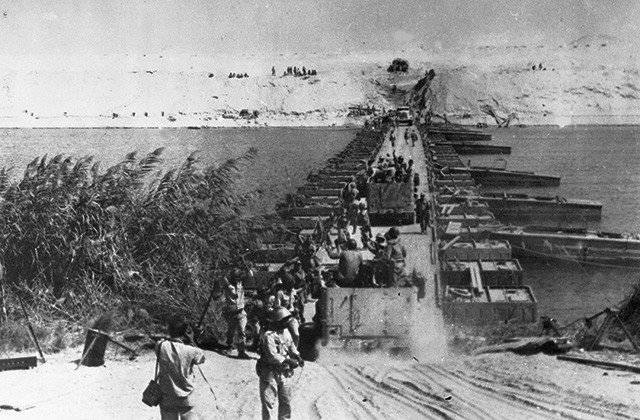
What did Egypt win by unleashing the Doomsday War?
The October war of 1973 (in Israel it is called the Doomsday War, after the religious holiday on which it began) became the last “full-fledged” Arab-Israeli war to date and, apparently, the most interesting classic war after 1945, “World War II with missiles” (Vietnam was not one of those). Then, of course, there were the Iranian-Iraqi, Ethiopian-Eritrean, a number of other, as it were, classical wars, but the warring parties and their actions were too primitive. But in the October war, not only the Israelis, but also, for the first time, the Arabs fought well, "at the highest level." There is still much to learn in this war, not only from a purely historical points of view.
By October 1973, the Israeli Armed Forces included 32 tank and mechanized, four airborne and artillery brigades, up to two thousand tanks, up to four thousand armored personnel carriers, about one thousand guns and mortars. The Air Force had up to 400 combat aircraft, including at least 100 F-4 Phantoms, at least 150 A-4 Skyhawks, more than 50 Mirages. The Navy consisted of 2 submarines, 12 missile and about 40 patrol boats.
In addition, Israel separated itself from the Arabs with powerful fortified lines. The main one was, of course, the Bar Lev Line along the entire eastern (Asian) coast of the Suez Canal. The depth of defense on it was 30 – 50 km. In the first line there were 33 strong points (in each infantry and platoon of tanks) 150 – 300 width and 200 depth, m, the distance between points - 6 – 10 km. There was a 100 concrete shelter. On the main axes, one kilometer of the front had 10 – 12 tanks and five or six anti-tank weapons. The height of the sand bank was 8 – 20 m, length - 160 km. Between the first and second line was a rokadnaya road, along which at least four tank companies patrolled. The second line was at a distance of 7 – 10 km from the first, and included company strongpoints. In the first and second echelons there were three brigades. And this is despite the fact that the channel itself had a width of 160 – 220 m and a depth above 15 m, i.e. was a major obstacle. A fortified line was built with a depth of 12 – 20 km and a width of 75 km and in the Golan Heights, against Syria.
The Egyptian Armed Forces had 12 divisions and 20 brigades, up to 100 PU ballistic missiles, up to 2,5 thousands of tanks, about the same number of infantry fighting vehicles and armored personnel carriers, more than two thousand guns, mortars and MLRS, up to 2,5 thousands of ATGM, more than 500 SAMs, up to two thousand MANPADS and up to three thousand anti-aircraft guns. The Air Force had up to 600 combat aircraft, incl. 18 bomber Tu-16 and 30 Il-28, 210 fighter MiG-21, more 100 attack aircraft Su-7. The Navy had 12 PL, five destroyers, three frigates, 19 missile boats (8 Ave 205, 11 Ave 183Р), more 40 torpedo and patrol boats.
Syria had five divisions and to 20 teams to 20 PU ballistic missiles, 1,5-2 thousand tanks to 1,5 thousand infantry fighting vehicles and armored personnel carriers, one thousand pieces, mortars and multiple rocket launcher systems, 2,8 thousand ATRA, 360 SAM, one thousand MANPADS, about two thousands of anti-aircraft guns. The Air Force had about 300 combat aircraft, incl. 110-180 MiG-21 and at least 40 Su-7. The Navy had nine missile (3 Ave 205, 6 Ave 183P), about 20 patrol and torpedo boats.
Other Arab countries took some part in the hostilities. Back in August, a Moroccan infantry brigade was deployed to Syria by two BDKs of the Soviet 5 th operational (Mediterranean) squadron. Algeria sent combat aircraft to Egypt 48 (23 MiG-17, 13 MiG-21, 12 Su-7). Already during the war on the Syrian front, Iraqi troops (300 tanks and BTR, 54 guns) and Jordan (150 tanks, 200 BTR, 36 guns) took part in the battles.
In 1972, Egyptian President Anwar Sadat expelled Soviet troops and military advisers from the country, since he decided that he could return the Sinai Peninsula only by “changing the camp” (as it turned out, he was right). However, military-technical cooperation with the USSR was not stopped, since Sadat wanted to reconcile with Israel and the United States from a position of strength, capturing at least part of the disputed Peninsula. It was impossible to do this without Soviet help.
The preparation of an offensive operation was a serious problem for Egypt, primarily because of the difficulty of maintaining secrecy. The Israelis understood the Arabs' mentality very well (in fact, the Jewish and Arabian mentalities are in many ways close), so they bought a lot of agents in Egypt and Syria, including very high ranking. The absence of surprise made even partial success impossible for the Arabs. However, this time everything worked out.
Until the very last day, only a few senior military and political leaders in Egypt and Syria knew about the upcoming war. In Egypt, with 1971, large-scale maneuvers were conducted several times a year in the canal area, which gradually eased the vigilance of the Israelis. In 1973, several such exercises were also conducted with partial mobilization of reservists. But unlike the previous years after the exercises, they were not dismissed to their homes. Thus, Egypt managed, unnoticed by Israeli agents, to fully mobilize and deploy a group along the canal.
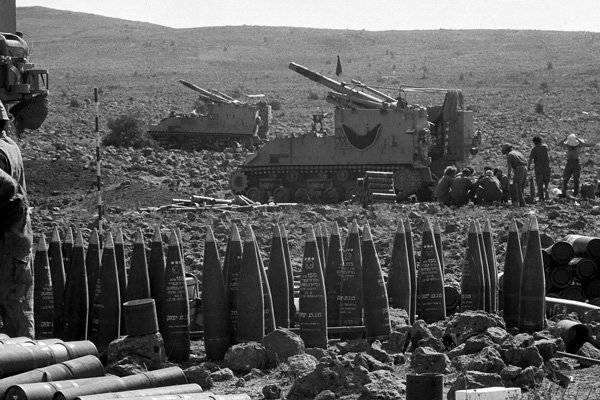
The Egyptian group consisted of two armies. The 2 (northern) had 2, 16, 18 infantry and 21 armored divisions, 3 (southern) - 7 and 19 armored divisions, 4-th armored division . An armored brigade was attached to each infantry division. Covered a group of eight anti-aircraft missile brigades (54 division C-75, C-125 and "Square"). They were confronted by Israeli forces, equivalent to three divisions with 280 tanks, their potential was greatly enhanced by the presence of the Bar-Lev line.
The offensive of the Arabs was timed to the same “Doomsday”, the Jewish holiday of Yom Kippur, i.e. 6 October 1973 g. The operation did not begin at night or in the morning, as is customary in most cases, but in 14: 00, when the sun had already passed to the west and began to shine into the eyes of the Israelis. True, the situation was reversed in the Golan Heights - the sun was beginning to shine in the eyes of the Syrians. But the position of Syria in its coalition with Egypt was openly subordinate, therefore the position of the sun relative to arms“Nobody in Cairo cared.
By the evening of October 5 in Tel Aviv realized that, it seems, tomorrow the war begins. On 6 in the morning of October 6, a decision was made on a general mobilization. Its mechanism in Israel has been worked out to full automatism, but in this case there was too little time left. At the same time, the Egyptian soldiers and even almost all the officers were sure that they would have next exercises. It was only in the morning of October 6 that the commanders of the units opened secret packages and learned that several hours were left before the war.
The Egyptian artillery preparation, which began in 14: 00, lasted for 53 minutes, during which time two thousand gun barrels and MLRS fired more than three thousand tons of ammunition (the intensity of the fire was 175 shots per second). During this time, the Egyptians built 10 pontoon bridges, and powerful water cannons in 70 places pierced the sand shaft of the Bar-Lev line. Forcing the channel by the first Egyptian units began in 14: 15, and by 17: 30, on the Asian side of the channel, there were 32 thousands of Egyptians and up to 200 tanks. Eight pontoon bridges for heavy equipment, four for infantry, and the 31 steam operated at this point. Attempts by the Israeli Air Force to attack the ferries stumbled upon the most powerful "umbrella" of the Egyptian air defense, and therefore led only to significant losses in aircraft with almost no results. True, the helicopter landing landed by the Egyptians in the depths of Sinai to capture mountain passes was destroyed by the Israelis, but this in itself did not change much.
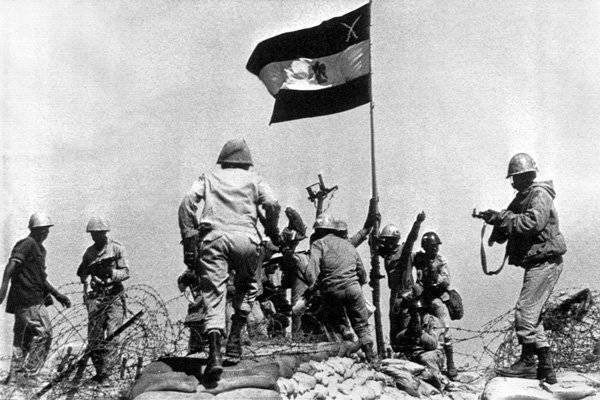
Planning the operation, the Egyptian command believed that when the canal was crossed, their troops would lose up to 25 thousands of people killed, while the real losses amounted to just 208 people. In general, forcing the Egyptian army of the Suez Canal 6 in October 1973 can be considered the most prominent separate military operation for the entire period from the end of the Second World War to the present day.
On the Syrian front, everything turned out not so well for the Arabs. As mentioned above, Damascus was forced to submit to the plans of Cairo, although he was much worse prepared for war and not interested in it at all. Moreover, with all their desire, the Syrians could not demonstrate such magnificence as the Egyptians when crossing the channel. They had to just stupidly squeeze out the Israelis with a mass from their positions on the Golan Heights, because of the narrow front and the complexity of the relief, there was not even a possibility for any workarounds.
The Syrian army had 5, 7 and 9 infantry divisions in the first echelon, 1 and 3 armored divisions in the second in the Golan Heights. The area between the Golan Heights and the border was covered by 7 anti-aircraft missile brigades. From the side of the IDF, the 7-i and 188-i armored brigades were holding the defense, behind them was the 136-i mechanized division.
At the very beginning of the offensive, a Syrian helicopter assault force occupied Mount Hermon, capturing several Israeli radar stations and an electronic intelligence center there, which brought sincere joy to Soviet military advisers. After that, the Syrian forces began to break through the fortified Israeli positions.
In the evening of October 6, the Israeli missile and one patrol boat inflicted a heavy defeat on the Syrian Navy at their main base in Lattakia, sinking three missile (4 Ave 1, 205 Ave 2Р) and one torpedo (Ave 183K) boats and a minesweeper Ave 123 and one torpedo (Ave 254K) boats and a minesweeper Ave. 30 and one torpedo (Ave XNUMXK) boats and a minesweeper Ave. XNUMX and one torpedo (Ave XNUMXK) boats and a minesweeper Ave. XNUMX and one torpedo (XNUMXK Ave.) boats and a minesweeper Ave XNUMX and one torpedo (XNUMXK Ave.) boats and a minesweeper Ave XNUMX and one torpedo (XNUMXK ave.) Boats and a minesweeper XNUMXK ave. Nevertheless, on the whole, the Arabs fully owned the initiative on both fronts. For the first day of the war, the Israeli Air Force lost XNUMX aircraft from ground defense alone.
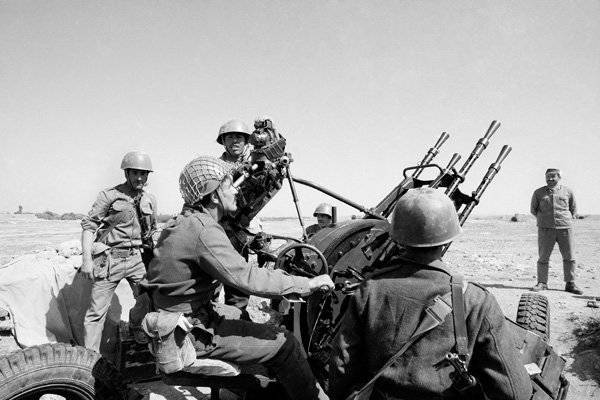
October 7 Israeli troops launched a fierce counterattack to restore the situation and throw the Egyptians into the canal, and the Air Force even more fiercely bombed the crossing. However, even direct hits in the pontoon bridges were not fatal, because the Egyptians quickly replaced the damaged sections. On land, Israeli tanks attacked almost without infantry support, which caused huge losses from the Malyutka ATGM and RPG-7, which the Egyptian infantry had in unlimited quantities. During the day, the Israelis lost at least 200 tanks, the Egyptians - 67. Egyptian troops continued to cross the canal and destroy the isolated fortified points of the Bar-Lev line. In the Golan Heights, the Syrian troops continued to squeeze the Israeli forces from their positions. The IDF brought into battle four additional brigades at once (14, 17, 19, 79), but the Syrians did not stop it. The 188 Brigade was almost crushed, its commander was killed. The same continued on October 8. The Israelis lost in the Sinai in fruitless counterattacks even before 100 tanks, the losses of their air force over the channel since the beginning of the war have already reached 50 aircraft, and the total - no less than 80. In the Golan Heights, the Syrians continued to push the Israelis to their western cliffs. October 9 at Sinai, the IDF lost even before the 80 tanks, the 190-I tank brigade was completely defeated, its commander was captured. However, the Egyptians also lost to 80 tanks. On the Golan Heights, the 7-I and 188-I Israeli brigades practically ceased to exist, their total losses since the beginning of the fighting exceeded the 200 tanks. Slightly less lost the other teams of the IDF, entered here in the battle to save the situation. True, the Syrians had already lost more than 500 tanks by that time.
On October 10, the offensive rush of the Egyptians in the Sinai fell sharply, and by October 11 it completely dried up. Sadat even exceeded the pre-war plan. He hoped, at the cost of huge losses, to capture at least a small bridgehead on the eastern shore of the canal, but in reality he had large bridgeheads with powerful groupings on them, and the IDF suffered huge tank losses in battles with the Egyptian army and aviation. The Egyptian president had no interest in advancing further. Therefore, the Egyptians did not even bother to do the absolutely necessary action - to connect the bridgeheads of the 2nd and 3rd Armies, separated by the Big Gorky Lake. Soon it played a fatal role for them.
In Tel Aviv they realized that the Egyptians did not want to attack anymore. After that, the main front for them was Syrian. The IDF in some areas was pushed back to the very edge of the Golan Heights. If the Syrians managed to overthrow the Israelis, it would be almost impossible to get back. Even in 1967, their assault was very costly for the Israelis, although the Syrian army was then incomparably weaker than in 1973, and Egypt and Jordan were already completely defeated by the time the assault began. In the event of seizing heights, the Syrians received direct access to the most populated northern areas of Israel, and could also conduct shelling of these areas. Therefore, the northern grouping of the IDF was brought up to three divisions and six brigades. October 10 Israelis regained the situation at the beginning of the war, and October 11 launched an attack on Damascus.
In the evening of October 10, Israeli missile boats almost finished off the Syrian Navy in Latakia, sinking two more missile boats (1 Ave 205, 1 Ave 183Р) and destroying most of the fuel reserves. On October 12, the 3-I armored brigade of the Iraqi Armed Forces entered the battle against the IDF, but was quickly defeated, losing 80 tanks (Israel - not one). It was much more difficult to fight against the Syrians. The promotion of the IDF was very slow and was accompanied by huge losses. However, by the end of October 13, the Israelis had to go all the way to the Syrian capital of the entire 30 km. In this regard, the Egyptian "standing on the channel" began to look like a direct betrayal (which, in general, was - Sadat cynically exposed Syria to defeat for the sake of their political goals that had nothing to do with the interests of Damascus).
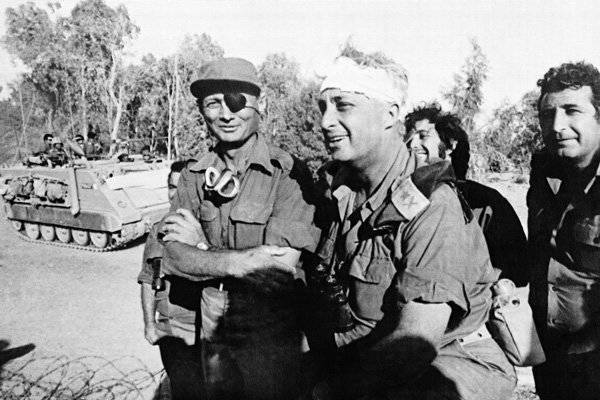
As the war continued, the Egyptian president could not completely ignore the interests of Syria. Therefore, in the morning of October 14, Egyptian troops launched an offensive immediately on the entire front in Sinai. This offensive resulted in a tank battle, which is considered the second largest in the history of wars after the battle of Prokhorovka. It ended deplorably for the Egyptians - they lost 264 tanks and up to 200 armored personnel carriers, Israel - no more than 43 tanks (maybe only 6). The Egyptians left the "umbrella" of their air defense, and also lost the direct support of the infantry with its "Baby" and the RPG-7. In the open maneuverable battle "tanks against tanks", the Israelis had obvious superiority due to the better training of the crews. In addition, AN-1 “Cobra” helicopters worked freely on the battlefield, which accounted for up to a third of Egyptian losses in tanks; Egypt simply did not have such helicopters at that time.
On the same day, he earned an air bridge, on which the United States began to transfer equipment to Israel to compensate for the losses. Since the situation could not be delayed, the Americans took it directly from their own parts in Europe. However, the bridge from the USSR to Egypt and Syria earned even earlier, and even here the equipment was supplied directly from military units.
Sensing a break in the situation, the Israeli command decided to seize the initiative, force the Suez Canal, and then surround and destroy at least one of the Egyptian armies, and maybe both.
The IDF launched an offensive on October 15. In the evening, two of its brigades entered directly into the center of the 16 and 21 Egyptian divisions, and this happened unexpectedly both for Jews and Arabs. The result was a chaotic night battle, reminiscent, according to the testimony of its participants, the Apocalypse. The Israelis lost 70 – 80 tanks, the Egyptians lost twice, and a huge amount of other equipment on both sides also burned. Both brigades of the IDF could not go on anywhere else, but they decided their task - they distracted the Egyptians from the crossing. On the night of 15 on 16 of October, the Israeli airborne brigade crossed over to the western bank of the canal in the region of the northern tip of Great Gorky Lake. The trophy floating equipment (7 tanks PT-76, 8 BTR-50) was involved in the boost, which contributed to the success of the event. The Egyptians did not attach much importance to what had happened, considering the crossing of the Israelis as nothing more than a small diversion. In addition, on the east bank of the 16-I and 21-I Egyptian divisions continued the battle with the 143-th and 162-th Israeli divisions, the sides suffered huge losses.
On the Syrian front of October 16, the 40-I armored brigade of the Armed Forces of Jordan, equipped with Centurion tanks, entered the battle. Its losses ranged from 20 to 28 tanks. Iraqi troops lost 60 tanks. This defeat of the Arabs, however, allowed the Syrians to regroup the 3 Armored Division and inflict a counterstrike. He did not bring victories, but the IDF’s offensive was completely exhausted, the losses were too great. The Israeli command no longer wanted to storm Damascus, because there was simply no power for that, and it could have had an extremely undesirable political effect — right up to the direct entry of the USSR into the war, about which Moscow warned almost openly. The main front was once again Egyptian.
On the morning of October 17, the Jews made their first bridge over the canal, along which the troops moved to the African coast, and then drove south, destroying the positions of the Egyptian air defense system and smashing the rear of the 3 Army. Only now the Egyptian command realized that this was not a small diversion and it was feverishly making efforts to eliminate the crossing. The 25-I armored brigade of the 3-th Army was thrown to the north, but during the day defeated by two Israeli brigades. By the morning of October 18, three Israeli divisions appeared on the western bank of the canal, the number of tanks exceeded 200. October 19 IDF launched a major attack on the south. To this day, they have already destroyed the 15 divisions of the Egyptian air defense missile systems. Egyptian counterattacks were unsuccessful.
October 21 Israeli paratroopers returned Mount Hermon, but it was only a local success. The “minor” Syrians were able to successfully stabilize the front, but the Egyptians who triumphantly started the war ended it with a catastrophic defeat (after the war, Israeli officers confirmed that the Syrians fought better than the Egyptians, although both Arab armies fought incomparably better than in 1967). Now it is no longer Damascus, but Cairo is under threat of the Israeli offensive, respectively, Moscow threatened to send an airborne division to protect not the Syrian, but the Egyptian capital.
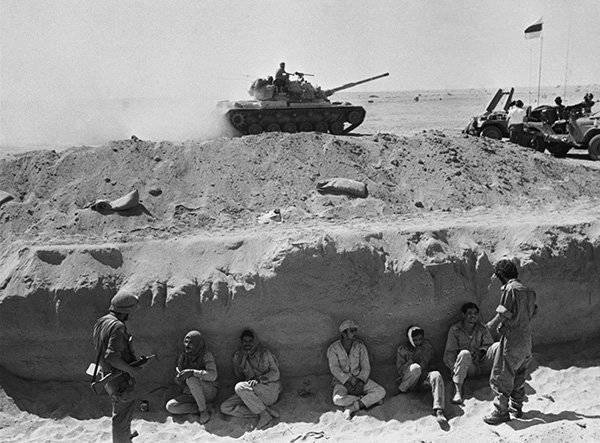
However, parts of the IDF did not go to the west, to Cairo, but still to the south. On October 23 they completely surrounded Suez, thereby finally cutting off the entire Egyptian 3 Army from theirs. The next day they tried to storm Suez, but to no avail. It was not possible to cut and crush the 3 Army itself on the eastern bank of the channel.
October 24 ceased fire on both fronts, the war ended.
To discuss the losses of the parties is extremely difficult due to the fact that both of them are prone to limitless lies, which will never recognize how many years have passed. Nevertheless, it is still possible to establish something.
Israel recognizes the loss of 2656 people killed, of which 772 on the Syrian front. From 300 to 500, people were captured, but after the war, all prisoners were returned. Losses in armored vehicles are extremely difficult to install due to the fact that some of its parts were subject to recovery. Apparently, Israeli losses exceeded 1,5 by thousands of tanks and armored personnel carriers, incl. no less than 800 units were lost forever. In general, tank crew members accounted for up to 60% of IDF casualties killed. The ease of victories in previous wars greatly failed the Israelis, who did not consider it necessary to support the tanks with infantry.
The Israeli Air Force lost on its own data 33 "Phantom", 11 "Mirage", 53 "Skyhawk", six "Super Misters" and six helicopters. Of them, allegedly, only five cars were lost in air battles with Egyptian aircraft, all the others were shot down by ground defense. American data adds a bit to this loss - two more Phantoms, one Mirage and three Skyhawks. In addition, at least six "Phantoms" were written off due to damage. Arab-Soviet data provide at least 200 Israeli aircraft shot down only by ground defense. Arabs, by the way, sometimes claim that more than 400 aircraft of the Israeli Air Force were shot down (taking into account air battles), but, as the Red Army soldier Sukhov said, "this is unlikely."
Israel apparently did not have any casualties at all (or a patrol boat made up the 1).
Egyptian losses ranged from five to 15 thousand people killed and about 8,5 thousands of prisoners, at least one thousand armored vehicles. Suppressed from the air and destroyed by the ground forces of the IDF 32 anti-aircraft missile division. Losses in airplanes are according to different data from 159 to 292. At the same time, according to Israeli data, 172 Egyptian aircraft were shot down in air battles, another 43 - ground defense, more than 60 were destroyed on the ground, or their own air defense, although the Egyptians themselves did not recognize the loss of aircraft on the ground. Egyptian Navy lost 6 missile boats (4 Ave 205, 2 Ave 183P).
Syria lost on its own data 1435 people killed, 1269 missing (i.e., really also killed, just 2704 in all), 309 captured, 1116 tanks, BMP and BTR, 435 guns, 13 anti-aircraft missile divisions (3 C-75, 5 C-125, 5 "Square"), 168 aircraft, five missile (2 Ave 205, 3 Ave 183Р) and one torpedo (123K Ave.) boats, one minesweeper (254 Ave.). Israel increases Syrian casualties to 3612 killed, 370 prisoners, 222 aircraft (of which 162 is in aerial combat, seven from ground defense). It should be noted that the human losses of the Syrians are much lower than those of the Egyptians, although there were no pauses on their front, unlike the Egyptian one.
Algeria lost 1 MiG-21 and 1 Su-7, Iraq - 21 aircraft (including 14 MiG-21).
Israeli "Phantoms" shot down Arabic aircraft to 115, with their own losses of at least 41. MiG-21 shot down Israeli aircraft on Arabic 144 data, although the Israelis themselves recognize no more than five. The real success of these Soviet fighters seems to be the 30 – 40 downed enemy aircraft with their own losses from 101 to 184.
The “large” Soviet-made SAMs (C-75, C-125, “Square”) shot down from 46 to 155 of the Israeli Air Force aircraft. The Strela-2 MANPADS accounts for seven to 18 downed airplanes, while the Shilka ZSU-23-4 ranges from 11 to 31. Israeli hawk-based air defense systems (US-made) shot down ten to 17 Arab aircraft.
Sadat got his way - from a position of strength, he reconciled with Israel and the United States, for which he received back all the occupied territories. During this, on the day of the celebration of the 9 anniversary of the triumph of October 6, he was killed by soldiers of his own army. Syria conducted an unnecessary war without triumphs, but without catastrophes, for which it did not receive anything. Israel, having won the hardest victory, made a big step towards the current creeping and sluggish surrender. In general, everyone lost.
Information